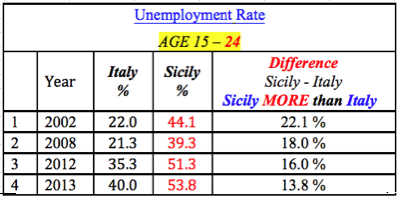Terroni-ism in Sicily Today
Terroni-ism in Sicily Today
(September 26, 2014)
Consistent with the theme of this blog (i.e. the Mediterranean heritage of near seventeen million Americans of southern Italian descent), the first sentence in the abstract of a recent article in “Acta Medica Mediterranea – International Journal of Clinical Medicine” is significant. The authors write: “The economic crisis that started in 2008 in many countries of the world, has resulted in the reduction of many jobs in all the regions of Italy, most ESPECIALLY in the Southern part of the Country”(emp.+). /// /// The authors go on to posit statistics that demonstrate significant differences in the effects of the “economic crisis” between the Sicilian population and Italy as a whole, in terms of labor and health. /// /// This blog has relentlessly argued that the people south of Rome and their American progeny are culturally the products of near three-thousand years of Mediterranean culture (e.g. Greeks, Arabs, etc.). Whereas northern Italy’s history and culture is rooted in the post-Roman Empire Eurasian Steppes’ migrations (e.g. Lombards, Franks, etc.) and their corresponding state structures (e.g. Carolingian and Holy Roman Empires). /// /// The historic and contemporary cultural and economic differentiation between northern and southern Italy post-Risorgimento, and the negative consequences for people south of Rome, has been factually documented and eloquently discussed by Pino Aprile in his book “Terroni”. He writes: “The South has been deprived of its institutions; it has been deprived of its industries, its riches and of its people (with an emigration that was induced or forced unlike any other group in Europe).” /// //// Remember, post-Risorgimento Italian Prime Minister Nitti infamously told the people south of Rome: “Brigands or Emigrants”. After the failed 1866 Sicilian brigands revolt, the Sicilians emigrated in mass. Near five million of their progeny reside in America today. /// /// The “Acta” article provides further documentary evidence that contemporary Sicily still suffers the negative consequences of the 1860 conquest and de facto colonization by the ‘Piramuddisi’ (Sicilian pejorative for “Piemontesi”) .
Preface
see http://www.actamedicamediterranea.com/medica/2014/med2014_pag-1129-1136.pdf
Note:
Also, importantly, the authors should not be associated with the Terroni cultural history theme of this blog article. Theirs is purely Occupational Medicine. I have only taken selective factural and verifable data from their article as supporting evidence of my Terroni thesis.
In short, Verso and Piccoto are consummate medical research professionals … I’m a kibitzer.
//////
For example, in May 2013 the US Department of Labor reported the following annual wage comparison of three labor categories:
For example, Table 1 (rows 3, 6, 9) below shows the Difference between Sicily’s industrial employment and Italy as a whole.





Note especially the "Unemployment Rate" with more than twice as many Sicilians unemployed (on a percentage basis) as Piedmontesi!

Further, both the economic data and medical data show Sicily at a distinct disadvantage vis-à-vis Italy as a whole.
Economics is a determinate of culture.
And, the cultural and historic implications of south of Rome economic statistics are important for southern-Italian Americans to understand.
Similarly, Sicilian Americans and other Americans of southern-Italian descent have (are) experienced (-ing) the same “cultural lobotomy”; i.e. deprived of their culture and history. They know nothing about their pre-Ellis Island history and culture.
The same dominant northern Italian culture forces, pervasive in southern Italy since 1860, also dominate southern-Italian Americana. For example, as this blog has repeatedly documented, the crème de la crème in the American university system and mass media are philo-Piramuddisi!
This work may not be reproduced, in whole or in part, without prior written permission.
Questo lavoro non può essere riprodotto, in tutto o in parte, senza permesso scritto.










Targeted Email Database Services
Good Info. I am very impressed about it.
Thank you, William.